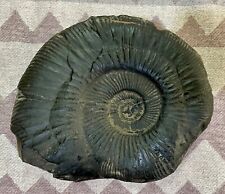|

On eBay Now...
Rare Large C1 Titanothere Atlas Vertebra, Fossil, Brontothere, SD Badlands, T781 For Sale

When you click on links to various merchants on this site and make a purchase, this can result in this site earning a commission. Affiliate programs and affiliations include, but are not limited to, the eBay Partner Network.

Rare Large C1 Titanothere Atlas Vertebra, Fossil, Brontothere, SD Badlands, T781:
$749.95
Type: This is a fossil C1 Atlas neck vertebra from the Titanothere, Titanotherium ingens, (often called Brontothere also). These are the rarest vertebrae and they would have connected directly to the cranium. These are normally only found as fragments as the hollow shape of the bone caused most to not survive fossilization intact. I have made a steel stand on a solid red oak stand for display. Will make a nice addition to the collection.
Weight: 3 pounds 14 ounces
Locality: Private land in Pennington County, South Dakota
Age: Late Eocene to Early Oligocene, 35 Million Years Ago
Read below for information about the specimen.
Note that ruler increments are 1/16 inch.
Brontotheres
Titanotheres and Brontotheres, (giant elephant-like creatures)
During the Eocene, brontotheres represented the largest mammals found in North America. Brontotheres were large robust animals, with the last forms reaching 14 ft in length and 8 ft at the shoulder. The body appeared to have the form of a rhinoceros but with more elephant-like legs and feet. The head is large and stocky with small eyes located to the front of the head and ears far in the back. The teeth are large and blocky, some of which reach a diameter of 4 inches and possess advanced adaptations for crushing and grinding plant material. Skulls of later genera often possessed large bifurcated horns on their nose, with a great variety of different shapes and sizes present in different specimens.
Fossil brontotheres are commonly found in the White River beds of the western U.S., but usually are represented only as fragmented teeth or bones. Recorded initially from the Wassatchian NALMA of the early Eocene as small, dog-sized mammals, the last forms from the Chadronian NALMA of the latest Eocene were the size of medium-sized elephants. Remains of large forms from the Chadronian NALMA are the most commonly found and the three genera currently recognized from this time period, each with several species, include Megacerops coloradensis, curtus, kuwagatarhinus, and platyceras; Menops variens, crassicornis, serotinus, trigonoceras and walcotii; and Brontops robustus, amplus, bicornutus, brachycephalus, dispar, selwynianus and tyleri . Early genera such as Titanotherium and Bronotherium are now considered synonyms of the above taxa. Many of these species are recognized by variations in horn, tooth and skull structure. Titanotheres also show sexual dimorphism, primarily in the form of larger skull and horn sizes in males.
Early paleontologists discovered gradual changes in the skulls of brontotheres found at different levels, with horn cores generally becoming longer and larger, incisors generally decreasing in number, and nasal canals tending to shorten as the formations approached the end of the Eocene. In some of the youngest beds, skulls lack all incisors, possibly as an adaptation allowing for a more prehensile lip.The life of brontotheres is still inconclusive, with many species, and especially the last forms, being compared to modern rhinoceroses. Others feel that consideration should be given to brontotheres being a late Eocene ecomorph of the African elephant. If African elephants can be described as very large browsers replete with tusks that function during feeding and fighting conspecifics, they compare well with brontotheres of the late Eocene. Both families evolved from unremarkable ancestors the size of pigs or tapirs, with little indication of their final form. During their evolution, however, both groups grew to gigantic proportions, the varying shaped horns of the final genera of brontotheres, Megacerops, Menops and Brontops, having large nasal horns which appear to be used primarily in conflict with other males. Final forms developed structures on their noses that became spectacular bifurcated structures. Most speculate that these horns were used primarily for intra-specific combat, with contemporary species using their horns in different means of attack: frontal, lateral and as locking mechanisms much as co-existing bovids fight intra-specifically in widely differing fashions depending on the nature of their horns.
Brontothere dentition strongly suggests they were obligate browsers, just as some populations of African elephants are. Often compared to rhinoceroses, later brontotheres are far larger than heterospecific rhinoceroses like the browsing Subhyracodon that co-existed with them during the late Eocene. Modern elephants of Africa do or did co-exist with two species of rhinoceros and in Asia, the same could be said until recently about Asian elephants and any of three species of rhinoceros that do or did co-exist with them. In essence, brontotheres are best described as being very large browser-grazers which do or did inhabit both forest and open woodland habitats.
Brontotheres are thought to have preferred warm temperate to subtropical environments in habitats that ranged from closed forests to relatively open river-marginal woodlands. All three of the final genera have been recorded in northern Colorado, western Nebraska, eastern Wyoming, the badlands of South Dakota, and northward into Saskatchewan. The fact that all three have been found in geographical proximity to each other suggests each genus utilized a distinct niche, perhaps one defined by vegetation type or foliage density, a niche that allowed all three genera and their respective species to co-exist ecologically. Although it is thought that a general cooling and then drying trend throughout their range is largely responsible for their disappearance, more complex factors such as the continued reduction of forest cover and the resultant loss of preferred foods may also have been involved. Regardless, titanotheres disappeared as their forest habitat also disappeared, unable to adapt to the opening habitat as the smaller rhinoceroses did. Brontotheres are only recorded from the Eocene epoch and all forms disappeared at the end of the Chadronian. Once gone, this niche was not immediately filled by a very large browsing ungulate, and would remain vacant in North America for 12 million years until the arrival of proboscidians during the late Miocene epoch.
Written by Alan S


Ultra Rare Large Ajoite Crystal with Copper & Hematite Inclusions & Epidote Coat $12000.00

Rare Large Cigars Brown Ceramic Ashtray, 4 Cigar Rests $32.25

RARE large 1970s WESTWAY MODELS BRITISH AIRWAYS CONCORD AIRPLANE Bulova 49 inch $1500.00

Retro 5 Inch Unused Rare Large Silver Bowl Pipe 70’s With Roach Clip $94.99

Pipe Very Rare NEW Barling 1950s Ye Olde Wood EXEXEL Extra Large Apple 266 $1200.00

Rare Large Flying Cardinal Topper for Ceramic Christmas Tree Lights Bulbs Star $15.95

Exceptionaly Rare- Large, Early Saint Agatha Religious Medal featuring 3 Saints $449.99

RARE Large Saligram-Ammonite Fossils from Himalayan Mountains Nepal 2,374 gms $629.89
|